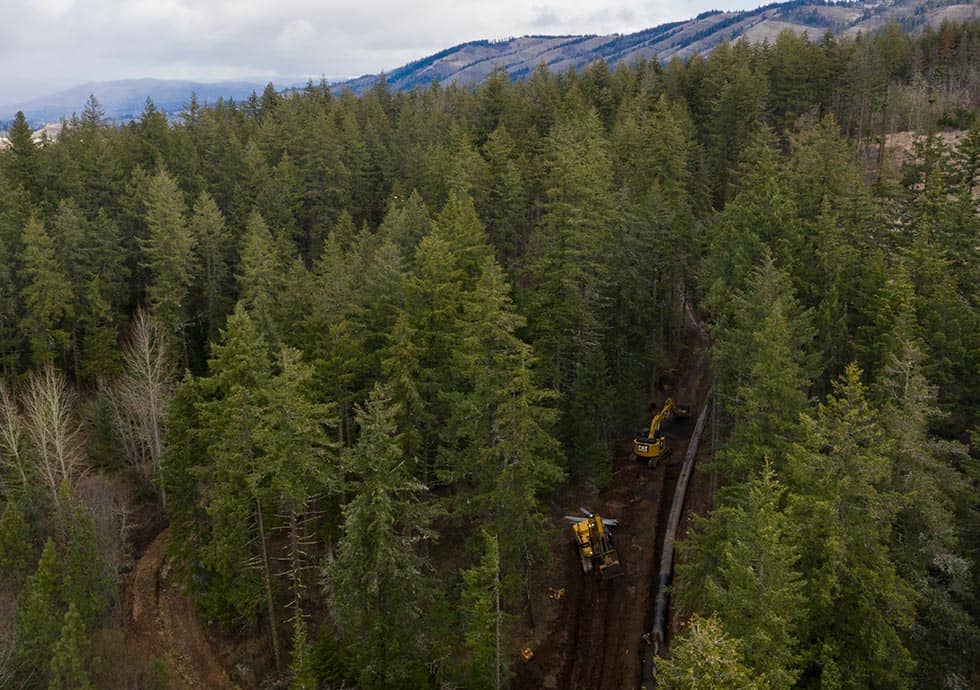Three decades of collaborative restoration in the Hood River Watershed.
The three forks of the Hood River drain a steep basin on the north side of Mt. Hood, a drop from over 10,000 feet to almost sea level in just 22 miles. The pristine water coming from the mountain’s glaciers and springs creates one of twelve cold water refuges along the Columbia River, a vital habitat for salmonid spawning. By the 1990s, a century of impacts from logging, agriculture, human-made impediments, and over-fishing had threatened the sustainability of the iconic fish species. The fish would soon be listed under the Endangered Species Act, a designation that would bring stricter regulations that would affect farming in the valley.

The fix was not easy. It required improving spawning habitat, restoring riparian zones, removing obstacles to upstream fish passage, and changing the way irrigation worked within the natural system. Fortunately, stakeholders like the Hood River Soil and Water Conservation District, the U.S. National Forest Service, the five irrigation districts, Oregon Department of Fish & Wildlife, the Confederated Tribes of Warm Springs, and individual residents sat down to have difficult conversations that, over three decades, have shown how a healthy watershed can benefit farms, fish, and the local community.
“When I originally started at the district,” says Craig DeHart, manager of Middle Fork Irrigation District, “we would divert water from Coe or Eliot Branch, which are turbid in the summer months, and put that water into an otherwise clear stream and use that creek to convey the water into other pipelines and diversions and then out to the users. That is pollution. It’s a waste of water. And we began in earnest in about 1990 to eliminate those and we pretty much eliminated all our use of creeks as open conveyance by 2006.”
Everyone seemed willing to try improvements, and a lot of it had to do with the simple act of regularly meeting face-to-face, talking about Little League games amidst difficult conversations about finding consensus.
“We were just open,” says Rick Ragan, a hydrologist with the U.S. National Forest Service. “We were willing to try something new and accept that there would be mistakes. And we were willing to work with folks, even if it wasn’t gaining everything that we wanted. The idea was to keep an eye on improving the habitat and go from there.”
“We were willing to work with folks, even if it wasn’t gaining everything that we wanted. The idea was to keep an eye on improving the habitat and go from there.”
Rick Ragan, hydrologist with the U.S. National Forest Service
“I’ve been working here almost 30 years,” says Lillian Dick of the Confederated Tribes of Warm Springs (CTWS). “When I first started, you could go to Toll Bridge Park in August, and you could walk across the East Fork Hood River and not get your ankles wet. It’s not like that anymore. It’s a lot better.”
The Endangered Species listings propelled a willingness to collaborate among Hood River stakeholders, and the results are apparent in the valley. The first thirty years began by addressing impacts from the past. The next thirty years will require adapting to a future with a changing climate.
“The partnerships that have formed here have set us up to deal with the challenges of climate change,” says Cindy Thieman, Coordinator for the Hood River Watershed Group. “ We created a basin-wide strategic action plan that we call Watershed 2040. The goal over the next 20 years is to complete all the water conservation and habitat restoration that we estimate needs to happen to recover salmon and steelhead populations and prepare the Hood River Valley for resilience to climate change.”
Les Perkins manages the Farmers Irrigation District: “I’m hopeful that all the work that we’ve done over the last 30 years and the work we have scheduled in the next decade, will put us in a place where we can manage the challenges we’ll face from climate change. And I think we’re one of the most prepared and most adaptable basins to be able to do that.”
“The Hood River Basin serves as an example of how fish, farmers, and communities can all thrive in one basin,” says Julie O’Shea, Executive Director of Farmers Conservation Alliance, based in Hood River. “The collaborative nature of this community has led to a number of amazing breakthroughs that address habitat, fish passage, and agricultural resilience. It gives us so much hope for what is possible in the future.”






